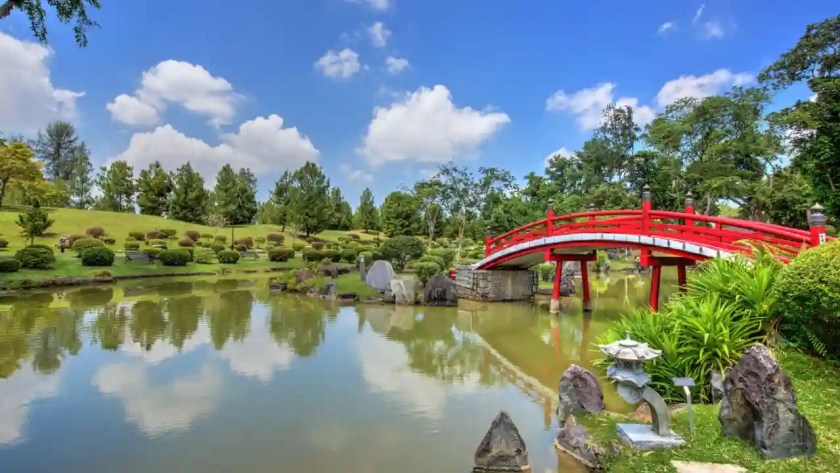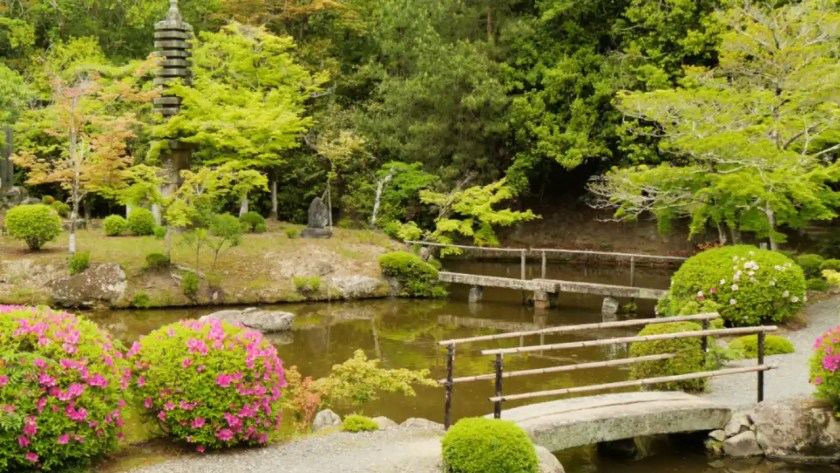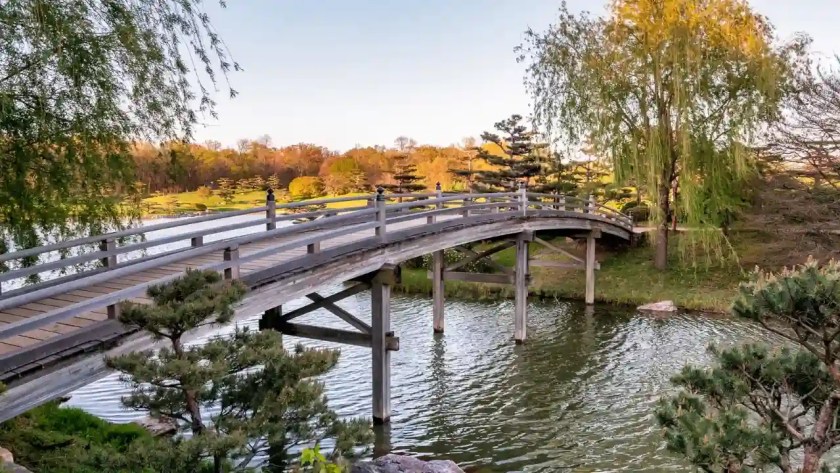Japanese gardens do build bridges as they are helpful in getting from A (A point) to B (to another point). From a spiritual point of view, a bridge permits a person to ‘travel’ from the earthly realm to a ‘happy’ place, which is an afterlife.
Japanese bridges are built with different materials, with size and shape developed on the owner’s wishes.
The Importance of Red Bridges in Japanese Gardens

The arched red bridge, referred to as the Guzei, reigns as the most recognizable in Japan’s gardens.
Red is considered to be a significant color representing wisdom in Japan.
This color also pushes you to engage in a process of detaching from your loves for material goods as you walk the bridge.
Amazing Color: It also facilitates spiritual change and positive growth..
Type of Japanese Garden Bridges
Japanese garden bridges can be made from many materials such as:
Wood

Wood is among the most commonly used materials because its affordable and easy to work with.
You can build a wooden bridge from hardwood, bamboo, wood boards, or railway sleepers. They are long-lasting and will hold up against any weather condition.
Stone
Stone is frequently used to construct Japanese bridges as well.
The blocks of stone can be square, flat, or circular.
Just be sure to have steel or wood support the stone blocks so the bridge will stand straight.
Concrete
Building a concrete bridge requires figuring out how to become a skilled and professional bricklayer.
However, they are robust and resilient structures.
Get Creative: The best part about concrete is that you can mold it into any shape you can imagine.
How to Make a Japanese Garden Bridge

Here is what you need to make a Japanese bridge.
Materials
- Three arched pressure-treated pieces of wood
- Wooden planks
- Cement
- Measuring tapes
- Drill
- Screws and bolts
- Nails
- Hammer
- Insulating coating
- Paintbrush
Procedure

- Select the optimal area of the garden you want to create the bridge. After that, you will want to measure the broadness of the creek or valley.
- You will want to order three (3) pressure-treated solid pieces of wood, five inches longer than the creek or valley, but be steeped.
- You can place the three (3) pieces of wood over the ground, on the construction site of the bridge. The pieces of wood should demonstrate an arch. Also ensure, once the arches are constructed, the wood details overlap both sides of the future bridge, and removed.
- You will then want to dig two furrows below the ends of the bridge. You can use a shovel or ground auger to do this. Make the furrows deep enough to support the bridge and its weight.
- After you have dug the furrows, you will pour concrete into the furrows. Please allow the concrete to dry completely.
- After the concrete is dry, take the drill and create holes into the wood and into the cement. Place the bolts and screws into the holes also, to secure the pieces of wood to the dry concrete.
- When the pieces of wood are secured tight in place, cover the wood-piece with more pieces of wood, secured by nails and a hammer.
- To secure the pieces of wood even tighter into the ground, place a strip of cement into various junction points, thus securing the bridge in the ground, tighter.
- Last, you can coat the piece of wood with a layer of insulating coating to preserve its appearance longer.
How to Select the Shapes and Design of the Bridge

Identify the design of the bridge you desire for your garden and print it on a large sheet of paper.
Next, cut out the shapes of the bridge, and place them on a photograph with the view of where you want to build your bridge.
This will help you know whether the plan will fit in appropriately or not.
In the main: You need to use rectangular and arched designs. Rectangular designs are easier to deal with, yet they cannot match the sophistication and classic quality that their arched cousins possess.
Elements of Japanese Gardens

A Japanese garden, in addition to the presence of bridge features, uses ponds, streams, islands, and hills to create an artificial imitation of scenery found in nature-surely, one of the popularly used features of the gardens.
The following is a look at some of the more commonly used elements of Japanese gardens.
Stone, Sand, and Gravel
Stones have always been important in Japanese history. When we think of stones we think of mountains and hills, symbols of durability; small rocks and gravel symbolize ponds and streams.
Ponds, Streams, and Waterfalls
Ponds play an important role in Japanese gardens that signify water bodies (e.g., lakes and oceans).
Shrubs frequently create the border of a pond, although it is common practice to plant more fertile plants such as rice or lotus in or near ponds.
Ponds also provide shelter to educational carps and are another element of color and activity to your garden.
For the garden where tides are an influencing factor, ponds can be used for boating and other recreational uses.
Islands and Bridges

Islands also have a presence in Japanese gardens.
Islands can be large or small, ranging from a stone outcropping to one large enough to build a building on.
Bridges, that connect the islands to ponds, can be built of wood or stone.
Vegetation
There are various types of plants used in Japanese gardens as well. There are flowers, trees, and shrubs.
Cherry trees and maple trees are commonly used in Japanese gardens to depict the seasonality of plants.
Conversely, bamboo and pine delineate beauty and are mostly used during the winter months when all the other plants are dormant. The arrangement of plants around the garden reflects nature, and a lot of time is spent on the aesthetics of the plants.
If you want to know: trees and shrubs are pruned frequently. In the winter straw insulates and protects plants and trees from damage from snow or cold. Straw wraps also help to provide layer and protection for plants from possible insect infestations.
Paths

Following the advent of strolling and tea gardens, pathways can now be viewed as a necessary part of the Japanese garden.
Strolling gardens have circular pathways composed of:
- crushed gravel,
- stepping stones,
- and compacted earth
for the highest level of controlled visitor viewing of the garden.
Wrapping Up
Whether you think of them as spiritual objects or objects of beauty, bridges are part of any Japanese garden.
For those who hold spiritual beliefs, the bridge represents a transition between this world, and the afterlife.
For others, the bridge is simply a pathway between different areas of the garden.
No matter the case, they are beautiful objects. You can’t have a Japanese garden and not have a bridge!